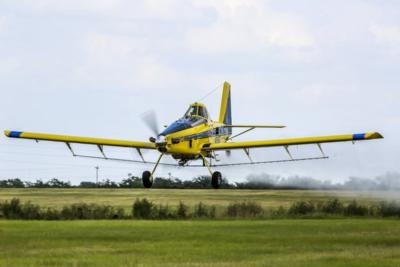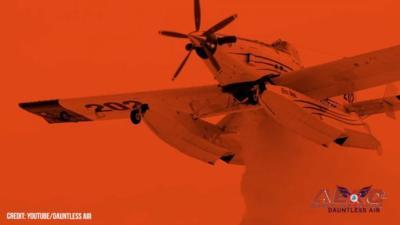Drones, Crop-Dusters, and the Necessary Space Between
As the efforts of American farmers bring about the onset of the nation’s growing season, the National Agricultural Aviation Association (NAAA) has respectfully requested that operators of Unmanned Aerial Systems (UAS)—drones, remote control aircraft, and the like—be mindful of low-altitude manned agricultural aircraft operations.

Every year, agricultural aviators—read crop-dusters—treat 127-million acres of U.S. cropland, and perform a variety of services by which crops are protected and farmers’ productivity is increased.
UASs and agricultural aircraft share the low-altitude, Class-E environment. In the absence of an FAA waiver permitting such operations, drones are not allowed above four-hundred-feet AGL; manned agricultural aircraft, for their own part, fly as low as ten-feet AGL while applying fertilizers, pesticides, etc. Ergo, the risk of midair collisions between agricultural aircraft and UAS platforms is perpetual and potentially deadly.
NAAA CEO Andrew Moore stated: “With the growing number of drones over the last few years, it is critical for their operators to be aware of low-flying, manned agricultural aircraft. It is extremely difficult, if not impossible, for manned aircraft to see a drone while conducting crop-enhancing and other aerial applications ten-feet off the ground at speeds as fast as 140-miles-per-hour. We encourage professional and hobbyist drone operators to keep this in mind to ensure a safe 2023 growing season.”
Aerial applications are currently underway in many parts of the U.S., and nationwide agricultural flying will peak during the coming summer months. A survey conducted by the NAAA near the end of the 2022 crop-dusting season found 22-percent of manned aerial application operators—more than one-in-five—reported at least one of their pilots having encountered a drone while operating an agricultural aircraft during the preceding year.
NAAA has and will continue to ply its institutional knowledge and experience to the business of educating professional and neophyte UAS operators in the proper use of such platforms and how to use drones safely in the vicinity of agricultural areas and manned agricultural aircraft operations. The NAAA urges drone operators to diligently and resolutely avoid agricultural aircraft performing vital low-altitude application operations. In addition, NAAA recommends that unmanned aircraft operators:
- Give manned aircraft the right of way—as specified in Federal Aviation Regulation.
- Equip drones with visible strobe lights, highly visible markings, and tracking technology such as ADS-B Out.
- Obtain UAS training and FAA certification.
- Advise local agricultural aviation operators prior to conducting UAS operations by consulting AgAviation.org/findapplicator.
- Land unmanned aircraft immediately in the vicinity of low-flying aircraft.
- Obtain and maintain unmanned aircraft liability insurance.
Small UASs are virtually invisible and potentially lethal to agricultural aviators, air ambulance helicopters, law enforcement, and other manned aircraft operating at low altitudes, high speeds, or both. In a test jointly conducted by the state of Colorado, the Colorado Agricultural Aviation Association, and agricultural aviation stakeholders, pilots operating manned aircraft were incapable of maintaining continuous visual contact with a 28-inch-wide drone while operating their aircraft at normal aerial application speeds. Though pilots proved capable of spotting UASs intermittently, such platforms are not constantly visible from the cockpit. Collision avoidance, therefore, is incumbent primarily upon UAS operators.
Bird-strikes are notoriously deadly to crop-dusters. A study conducted by the Alliance for System Safety of UAS through Research Excellence (ASSURE) showed UAS collisions with aircraft cause vastly more damage than collisions with birds of comparable size. As avian physiology comprises lightweight, hollow bones and soft-tissue attractively clad in raiments of feathers, drone architecture comprises dense and sizable batteries containing heavy and rare-earth metals, and motors of copper, steel, and ceramic—many of the same materials integral to the construction of antiaircraft projectiles.

Humankind depends in perpetuity upon consistently safe, abundant, and affordable supplies of food, fiber, and bioenergy—the overwhelming majority of which are produced commercially by farmers and safeguarded by crop-dusters. Manned agricultural-style aircraft—such as Air Tractor’s AT-802 turboprop family—are utilized to combat fires and eradicate disease-carrying mosquitoes and similarly deadly pests. All things considered, the importance of manned agricultural aircraft operations and the safety and security of such is of paramount importance to human societies worldwide.
Individuals planning to operate UAS platforms over the coming summer are asked to exercise circumspection and remain well clear of agricultural manned aircraft operations.
 Senator Pushes FAA to Accelerate Rocket Launch Licensing
Senator Pushes FAA to Accelerate Rocket Launch Licensing Classic Aero-TV: RJ Gritter - Part of Aviations Bright New Future
Classic Aero-TV: RJ Gritter - Part of Aviations Bright New Future Aero-FAQ: Dave Juwel's Aviation Marketing Stories -- ITBOA BNITBOB
Aero-FAQ: Dave Juwel's Aviation Marketing Stories -- ITBOA BNITBOB ANN's Daily Aero-Linx (10.27.24)
ANN's Daily Aero-Linx (10.27.24) ANN's Daily Aero-Term (10.27.24): Clearance Void If Not Off By (Time)
ANN's Daily Aero-Term (10.27.24): Clearance Void If Not Off By (Time)




